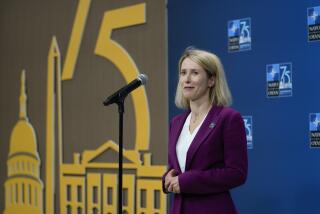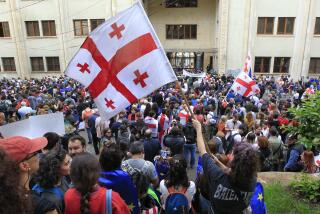Regional Outlook : 2 Baltic Nations Look West and East for Their Fortunes : Estonia and Latvia are rising from the Soviet wreckage, leaving Russia and Lithuania behind.
- Share via
TALLINN, Estonia — What would you expect from Europe’s youngest prime minister--a man who recruits Cabinet members from among his fraternity brothers? Who used to ride from village to town on a bicycle, collecting stories of Stalinist oppression and thumbing his nose at the KGB? Who relaxes to the music of Guns ‘N Roses?
Radical reform.
Here in Estonia, a country of forests and swamps about the size of West Virginia, Prime Minister Mart Laar, 33, and his team have raised their young country from the economic wreckage of the Soviet Union, putting a spotlight on the Baltic region, where Latvia is also pressing forward.
Although the Estonian economy shrank 20% in 1992 and 2% in 1993, the International Monetary Fund has predicted 6% growth this year. That would make it the fastest-growing economy of any in Europe or the former Soviet Union.
World Bank officials have told the U.S. Embassy in Tallinn, the Estonian capital, that “they would not be surprised to see 5% (annual growth) from this year to the year 2000,” said Ingrid Kollist, the embassy’s economic officer. “They’re very bullish on Estonia.”
Estonian officials say unemployment runs 2% nationally, and here in Tallinn--a charming European village turned boom town--it is virtually zero. The newspapers are full of help wanted ads.
Thousands of new businesses crop up annually, and Estonian exports doubled in value from 1991 to 1993, from 5 billion kroons to 10 billion ($725 million).
Much of the credit goes to the cruelly conservative policies of the Laar government: Social programs have been butchered, while state-owned factories have been told to turn a profit or fold. That and conservative monetary policies have kept the Estonian kroon stable and held inflation to 33% for 1993. In Russia, by comparison, annual inflation pushing 1,000% is the norm.
“If you look into history, we have done exactly what Germany did after World War II, only Estonia is doing it without the Marshall Plan,” Laar said in an interview in Toompea Castle, the government seat.
The chubby-cheeked leader and his ministers developed their game plan in college, poring over economics textbooks at Estonia’s elite Tartu University--the school Estonians with political aspirations dream of attending.
Laar, a historian, still attends the occasional fraternity party at the Estonian Students Society. He grins boyishly as he recounts his not-so-distant college days: He seems to have spent half his time hanging out with underground rock musicians, the other half gathering oral histories about resistance to the Soviet occupation of Estonia in the 1940s and 1950s.
“Who in this country has the experience for today’s problems? No one,” remarked Juri Luik, Laar’s 27-year-old foreign minister. “We at least gathered our experience from Western books, and we’re now trying to implement those ideas,” he said. And not without complaint.
Many Estonians say life is harder than ever. Average monthly salaries are about 1,200 kroons ($87), while senior citizens scrape by on monthly state pensions of 500 kroons ($36). Surveys suggest Estonians spend 40% of their income on food alone.
The budget is balanced, but government salaries and pensions are so low that Tallinn’s firemen frequently picket the Parliament. Approval ratings for Laar’s government hover around 10%.
Farmers, who make up a surly, subsidy-fattened lobby throughout the former Soviet Union, are particularly unhappy. Yet when farmers gathered earlier this month for an angry conference to demand more subsidies, Laar coolly suggested they package their products more attractively and hope Estonians will buy them.
“Of course we are not very popular,” Laar said in his office. “People complain that we don’t like the elderly, we don’t like children, we don’t like sports.
“This is the toughest moment for any government: when the economy zooms up but there’s no money in people’s pockets.”
Such nonchalance, according to 28-year-old Estonian Defense Minister Indrek Kannik, is the prerogative of youth.
“Younger people have their whole lives ahead of them,” he said. “They are more willing to make unpopular decisions.”
Popular or not, Laar’s program works. Two years ago, there were 2,000 private companies in Estonia. Today, estimates range from 40,000 to 60,000. Thirty percent of the population last year switched jobs--usually leaving the state sector for the private.
No other former Soviet republic has enjoyed such success. In nearby Lithuania, for example, a largely Communist government elected in 1992 and the powerful farmers lobby have gummed up efforts at reform. Inflation in 1993 was 183%, while salaries are about half those in Estonia.
Russia and Ukraine, drifting politically, have only fitfully tried to wean inefficient state-run factories from government money. Former Russian Economics Minister Yegor T. Gaidar had advocated Estonian-style radical reform, but the Russian Parliament thwarted his efforts and engineered his downfall this winter.
Indeed, among the former Soviet republics, only Estonia’s neighbor Latvia is doing half so well. Its numbers don’t look good, but they’re better than the rest.
Latvia’s economy shrank by 40% over the past two years, mostly, according to Economics Minister Ojars Kehris, “in the unproductive agricultural and industrial sector.” Kehris added that “many enterprises will go bankrupt in the near future, and that is normal and necessary.”
Latvia’s unemployment is 8%, and the government stands on a tenuous coalition of farmers and free marketers.
Prime Minister Valdis Birkavs, aware of an implicit comparison with Estonia’s Wunderkind, laughed wryly when asked his age. “I’m 51, but I feel much younger,” he said, and then defended his competence not by citing his distinguished law career--Birkavs was president of Latvia’s Lawyers Society, which in 1988 became the first freely elected lawyers society in the Soviet Union--but with a long discussion of his passions for tennis and sailing.
But Birkavs has a commendable record managing his country’s economy as well. Latvia’s 1993 inflation was an acceptable 35%, while aggressive bank reforms have made the capital, Riga, a blossoming financial center.
“We are not just the Switzerland of the former Soviet Union. We are in a position to compete with Switzerland itself as a world financial center,” Birkavs said. “Russians, Belarussians and other Soviets like to bank here, because they have old ties, and they don’t have a language barrier since we speak Russian.”
In January, 1993, Latvian banks held deposits of about 99 million lats ($174 million); by January, 1994, that figure had quintupled to 492 million lats. “You have a wave of money flowing over this country,” said Jonathan Bemis, economic officer for the U.S. Embassy in Riga.
Riding the crest of that wave is Latvia’s new currency--the handily named lat--introduced two years ago. The Estonian kroon, adopted at about the same time, was pegged to the German mark at 8 to 1 and has been one of Europe’s steadiest currencies. But the Latvians--out-free-marketing even the Estonians--let their currency find its own value. The result has been astonishing. While the Russian ruble and the Ukrainian karbovanets have tumbled, the lat has steadily climbed. One lat was valued at $1.17 in January, 1993, and at $1.70 in January, 1994.
“Today, the lat gains about two U.S. cents against the dollar every month,” said Economics Minister Kehris proudly.
Latvia is sandwiched between Estonia to the north and Lithuania to the south. Riga, a city of 900,000, is the largest Baltic port and the closest thing to a regional metropolis. Tallinn, a city and port half the size of Riga, looks quaint in comparison, while the Lithuanian capital, Vilnius, is a sleepy, landlocked town.
Riga’s size and location make it the commercial center of gravity. Foreign firms with an eye to doing business in Russia--Kellogg’s, for example, which is building a $22-million cereal factory--choose Latvia and Riga as headquarters.
“There’s an attitude in the business world here that it is Latvia’s future to act as a gateway to Russia, a Hong Kong, a stable platform for business with a large, troubled but economically interesting neighbor,” said Bemis.
Kellogg’s aside, however, most headquarters so far are largely symbolic offices. Uldis Vitolins, director of a government agency charged with courting foreign capital, said 1993 brought a mere $50 million in foreign investment.
Estonia is only now beginning to make noises about playing Hong Kong to the Soviet market. So far the Estonians have prided themselves on, in the words of President Lennart Meri, “cutting the colonial links” with the Soviet Union and forging new links with Finland.
Most of the $65 million in foreign investment Estonia enjoyed in 1993 came from Finland, while 80% of the tourists visiting Estonia last year were Finns. Estonian and Finnish are similar languages, and Estonians, who could tune in Finnish TV even in the pre-Gorbachev era, had a huge head start on glasnost.
Thanks to Finnish TV, for example, Estonians understand that when it comes to selling, a pretty wrapper is crucial. For instance, Estonian yogurt, fancily and brightly decorated, would look at home on the shelves of an American grocery store; Latvian yogurt is wrapped in a faded label.
While local business magazines hail the Renaissance of Estonian design, Estonian products have poured into northwest Russia in the past six months. Russians who would never buy anything “Soviet” snatch them up, convinced by the fancy packaging that they are buying Finnish.
“I have an Estonian toothbrush and Estonian toothpaste,” said George Shabad, 24, a sales representative for the Baltic News Service who travels often between Moscow and Tallinn. “My suit jacket is Estonian, my shirt, my tie. Estonian products are cheap and good; Russian products are expensive and bad.”
So who’s ahead--Estonia or Latvia?
Latvian Economics Minister Kehris parries the question by noting a free-trade agreement all three Baltic states signed last fall. The 200-page pact creates a single Baltic market of 8 million people and ultimately envisions open borders and a single visa regime. According to Kehris, the Baltics will rise and fall together.
The Estonians, for their part, prefer a different question: Who’s ahead--Estonia or Finland?
Most Estonians believe that the Soviet annexation of the Baltic states under the infamous Molotov-Ribbentrop pact sidetracked them from their rightful destiny as an economic superpower.
“If we had not been occupied, I think we would have displayed the same growth tendencies as those countries we were level with in the 1940s,” said Deputy Chancellor Peeter Tohver. “Countries like Finland, Sweden, even Germany.”
At least one important economic indicator puts Latvia ahead. Riga will get the first McDonald’s, tentatively scheduled to open in December. Tallinn’s McDonald’s should follow a month later.
Winning the Race While Russia’s economy sputters, Latvia and Estonia are moving ahead. *
* Latvia
Bank deposits (in millions of lats)
1993: 99.0
1994: 492.5
Source: Latvian Banking Assn. *
* Russia
Exports (in billions of dollars)
1991: 50.9
1992: 38.1
1993: 43.0
Source: Los Angeles Times files *
* Estonia
Exports (in billions of Kroons)
1991: 5.0
1992: 5.5
1993: 10.0
Source: Estonian government
More to Read
Sign up for Essential California
The most important California stories and recommendations in your inbox every morning.
You may occasionally receive promotional content from the Los Angeles Times.













